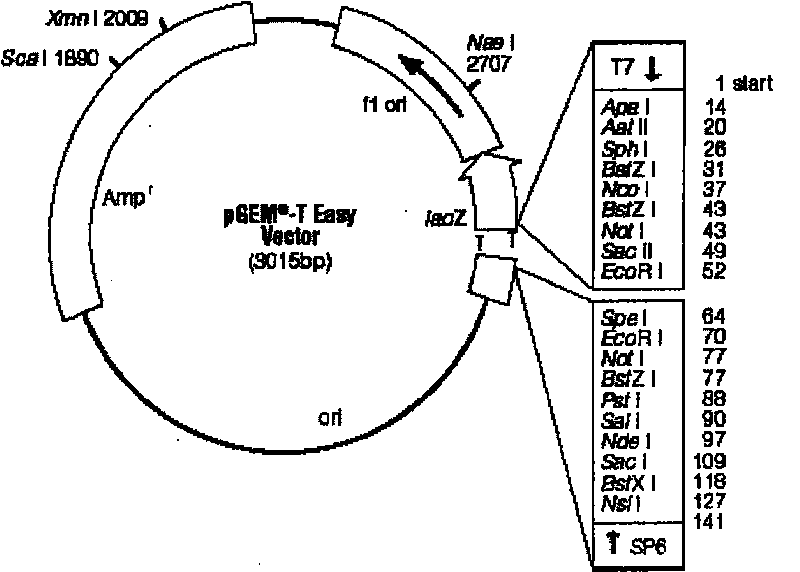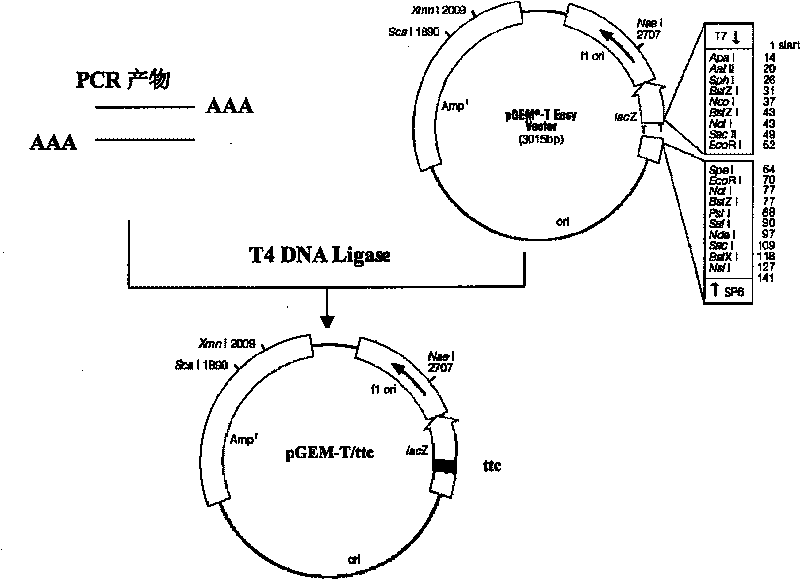Method for preparing tetanus toxin recombinant antigen and its use
A tetanus toxin and tetanus technology, applied in the field of genetic engineering, can solve the problems of low recovery rate, high toxicity, complicated C fragment steps, etc., and achieve the effects of good immunogenicity, prevention of hydrolysis, and easy reproduction.
- Summary
- Abstract
- Description
- Claims
- Application Information
AI Technical Summary
Problems solved by technology
Method used
Image
Examples
Embodiment 1
[0041] Embodiment 1, the amplification of tetanus toxin antigenic protein gene
[0042] (1) Preparation of amplification template
[0043] The toxin-producing strain CMCC64008 of Clostridium tetani was selected as the amplified strain. Inoculate the bacteria in bract meat culture medium, culture anaerobically at 35°C for 2 to 3 days, centrifuge at 4000rpm for 20 minutes, discard the supernatant, suspend the bacterial pellet in distilled water, freeze and thaw repeatedly in liquid nitrogen and room temperature 3 times, boil in boiling water for 5- 10 minutes, centrifuged at 10000rpm for 30 minutes, and the supernatant of the bacterial lysate was taken as the amplification template.
[0044] (2) Primer design
[0045] According to the tetanus toxin gene sequence in GenBank, primers with BamH I and Hind III restriction sites (indicated in italics) at both ends of the gene were designed, as shown in Table 1 below.
[0046] Table 1: Primer sequences
[0047]
[0048] (3) PCR...
Embodiment 2
[0050] Cloning and sequencing of embodiment 2, PCR product
[0051] (1) Purification of PCR products (glass milk purification)
[0052]After the PCR product obtained in the previous steps was separated by 1% agarose (Sigma company) gel electrophoresis, the target band was cut out under the irradiation of a long-wave ultraviolet lamp, and placed in a 1.5ml Eppendorf tube. Add 3 times the volume of sol solution (100 μl volume of gel to add 300 μl sol solution), 65 ° C for 5 minutes, during which the Eppendorf tube was shaken several times to completely dissolve the gel. Add 10 μl of glass milk (product of Boda Company) (mix the glass milk thoroughly before use), invert and mix, place in ice bath for 10 minutes, and mix every 2-3 minutes. Centrifuge at 12,000 rpm for 30 seconds, and discard the supernatant. Add 250 μl of rinse solution, blow the rinse solution with a pipette, gently suspend and mix the glass milk, centrifuge at 12,000 rpm for 30 seconds, and discard the superna...
Embodiment 3
[0069] Embodiment 3, construction of recombinant expression plasmid
[0070] The target gene on both sides of the recombinant cloned plasmid pGEM-T / ttc obtained in Example 2 has restriction endonuclease BamH I, Hind III recognition sites, and it is digested with these two enzymes to obtain the target gene. The expression vector pET-22b(+) (see Figure 5 ) connection, its construction diagram is shown in Figure 6 , transform the competent cells of Escherichia coli BL21 (DE3), extract the plasmids, and obtain positive clones through enzyme digestion identification. Agarose electrophoresis identification, there is a 1.3Kb fragment, which is the same size as ttc, see Figure 7 . The expressed plasmid is pET-22b(+) / ttc, and the reading frame analysis is shown in Table 3.
[0071] Table 3: Analysis of pET-22b(+) / ttc reading frame
[0072]
[0073]
PUM
| Property | Measurement | Unit |
|---|---|---|
| molecular weight | aaaaa | aaaaa |
| purity | aaaaa | aaaaa |
Abstract
Description
Claims
Application Information
 Login to View More
Login to View More - R&D
- Intellectual Property
- Life Sciences
- Materials
- Tech Scout
- Unparalleled Data Quality
- Higher Quality Content
- 60% Fewer Hallucinations
Browse by: Latest US Patents, China's latest patents, Technical Efficacy Thesaurus, Application Domain, Technology Topic, Popular Technical Reports.
© 2025 PatSnap. All rights reserved.Legal|Privacy policy|Modern Slavery Act Transparency Statement|Sitemap|About US| Contact US: help@patsnap.com



